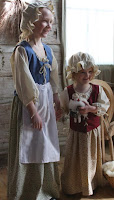 Now that we've mostly completed the Southwest Outbuilding and Northwest Stair Passage restoration and reinterpretation, staff is moving on to the next project on our list. This project is restoring and reinterpreting the slave quarters. The slave quarters were built in 1939, supposedly on original foundations (though archaeological work has not discovered those foundations). These buildings are the types that house slaves and skilled slaves might have lived in--they are much closer to the Great House and made of stronger materials (stone, instead of wood) than those lived in by field slaves. Thus, we are using what we know to help us tell the story of the enslaved people working in and around the house at Stratford Hall.
Now that we've mostly completed the Southwest Outbuilding and Northwest Stair Passage restoration and reinterpretation, staff is moving on to the next project on our list. This project is restoring and reinterpreting the slave quarters. The slave quarters were built in 1939, supposedly on original foundations (though archaeological work has not discovered those foundations). These buildings are the types that house slaves and skilled slaves might have lived in--they are much closer to the Great House and made of stronger materials (stone, instead of wood) than those lived in by field slaves. Thus, we are using what we know to help us tell the story of the enslaved people working in and around the house at Stratford Hall.Phil Mark will begin restoration on the buildings in May, and Gretchen Goodell is hard at work researching the people's stories that we are going to include in these buildings (you'll hear more about these parts of the projects in the coming months). We have two slave quarters--one will continue as an interpreted space, where visitors can learn about the enslaved people who would have lived here, their relationships, and their lives. The other slave quarters building is going to become a hands-on history area for families to use. This is where my work comes in.
I'm currently researching hands-on history areas at various historic sites and deciding what kinds of activities we will be including in our own. This space will be open during the same time as the Great House, and parents will be able to take their children there to do activities throughout the day. We will have fun activities available for young children--like building blocks--and we'll also provide 18th-century costumes that children can dress up in, a discovery chest for learning about some of the items that can be found at Stratford Hall, and colonial games that children will be able to play with throughout the day. These are just a few of the activities we'll be providing once this space opens in October.

We're hoping that having this hands-on space will give parents more activities to do with their children at Stratford Hall. Coupling the hands-on area with our Signers' Club program that's already available (this program is similar to the Junior Ranger program with the National Park Service) will provide a number of activities for children of all ages.
We'll be updating you throughout the summer on the progress on the slave quarters project!









